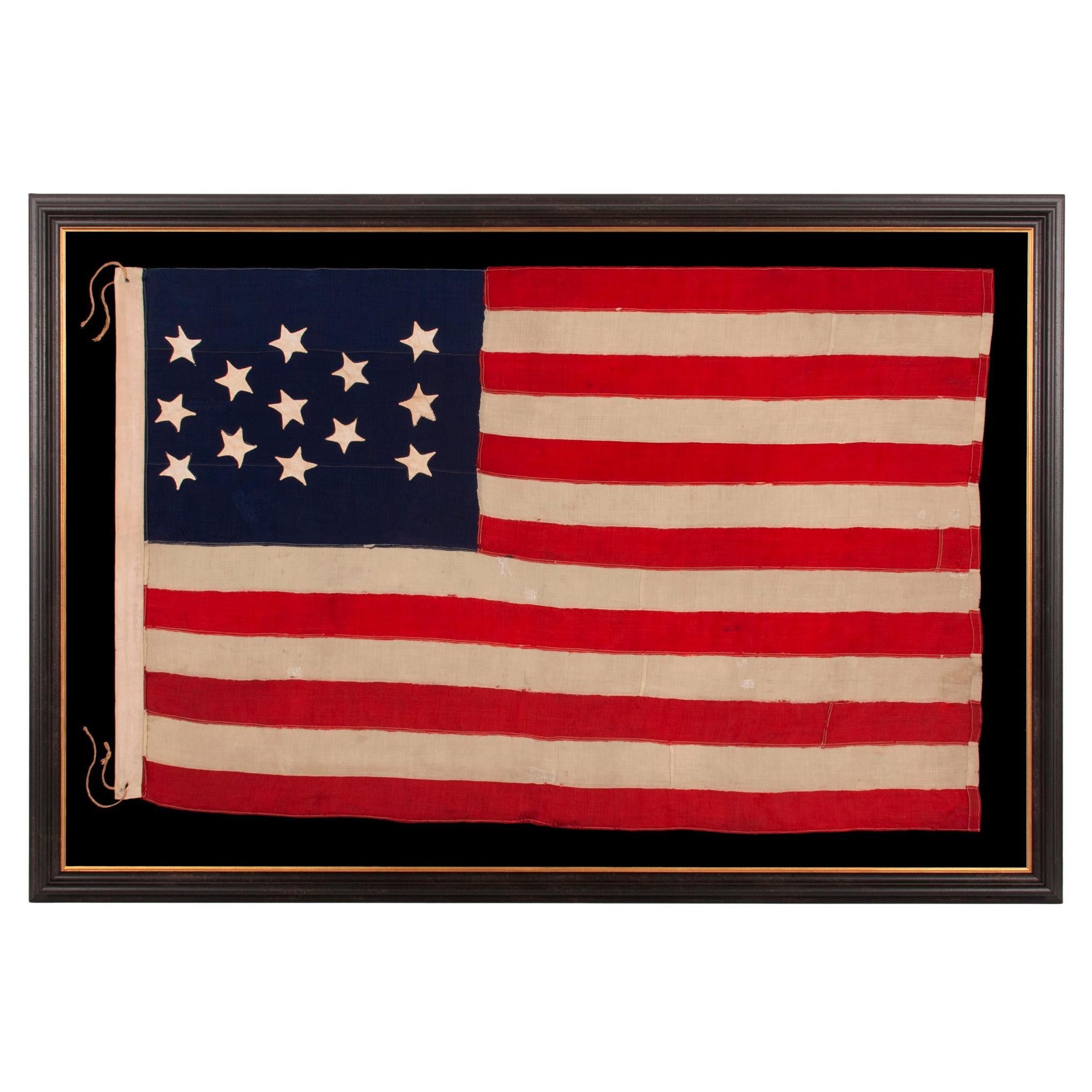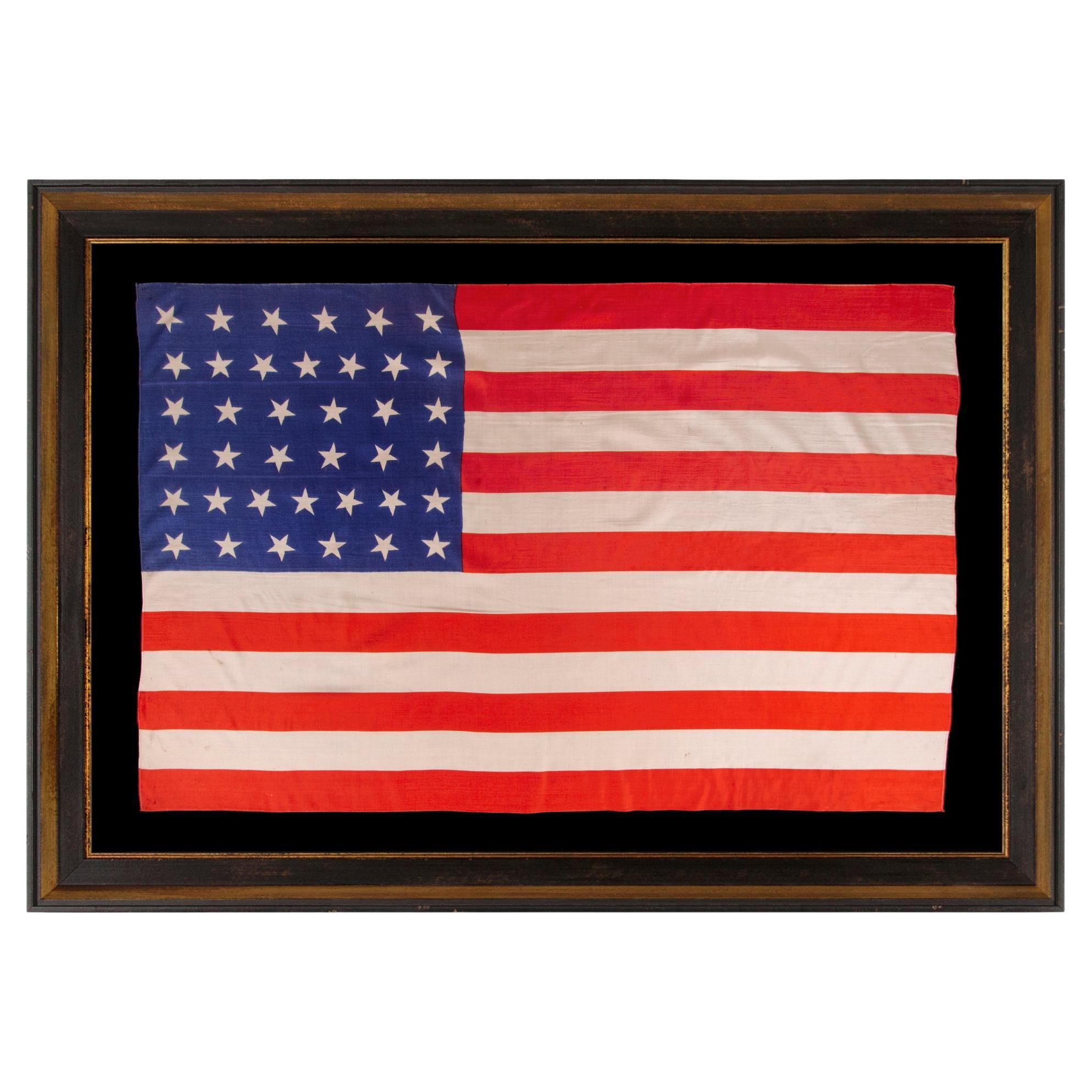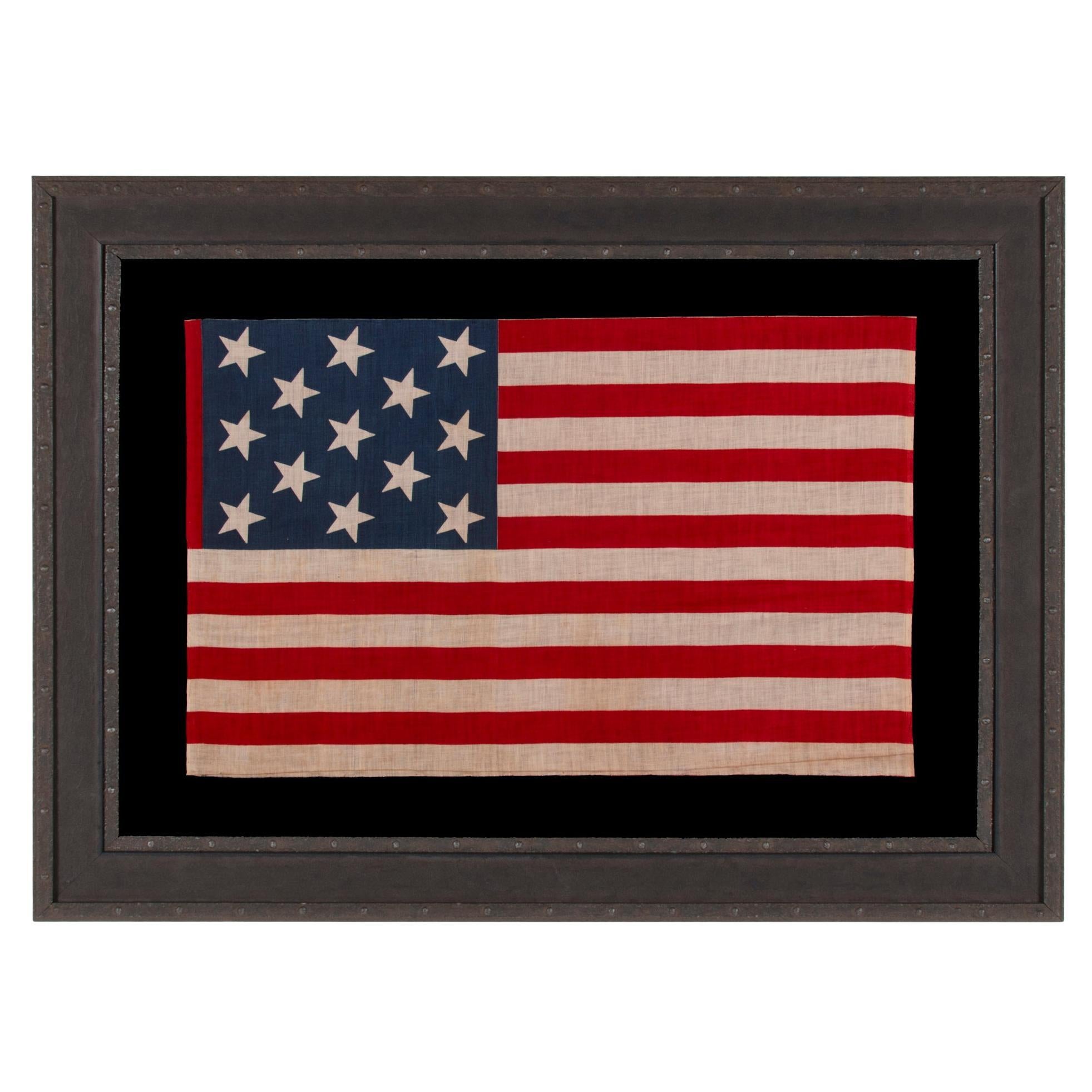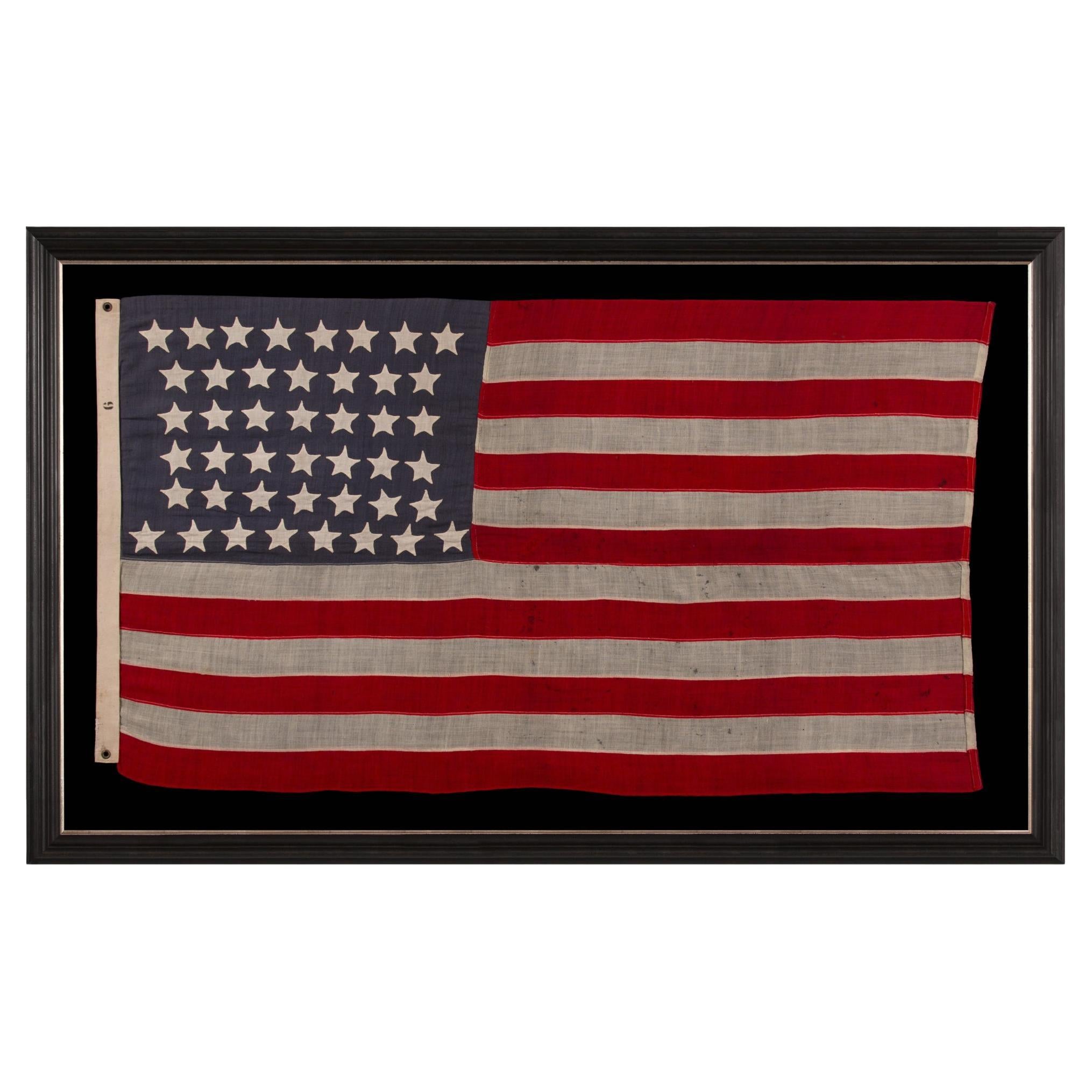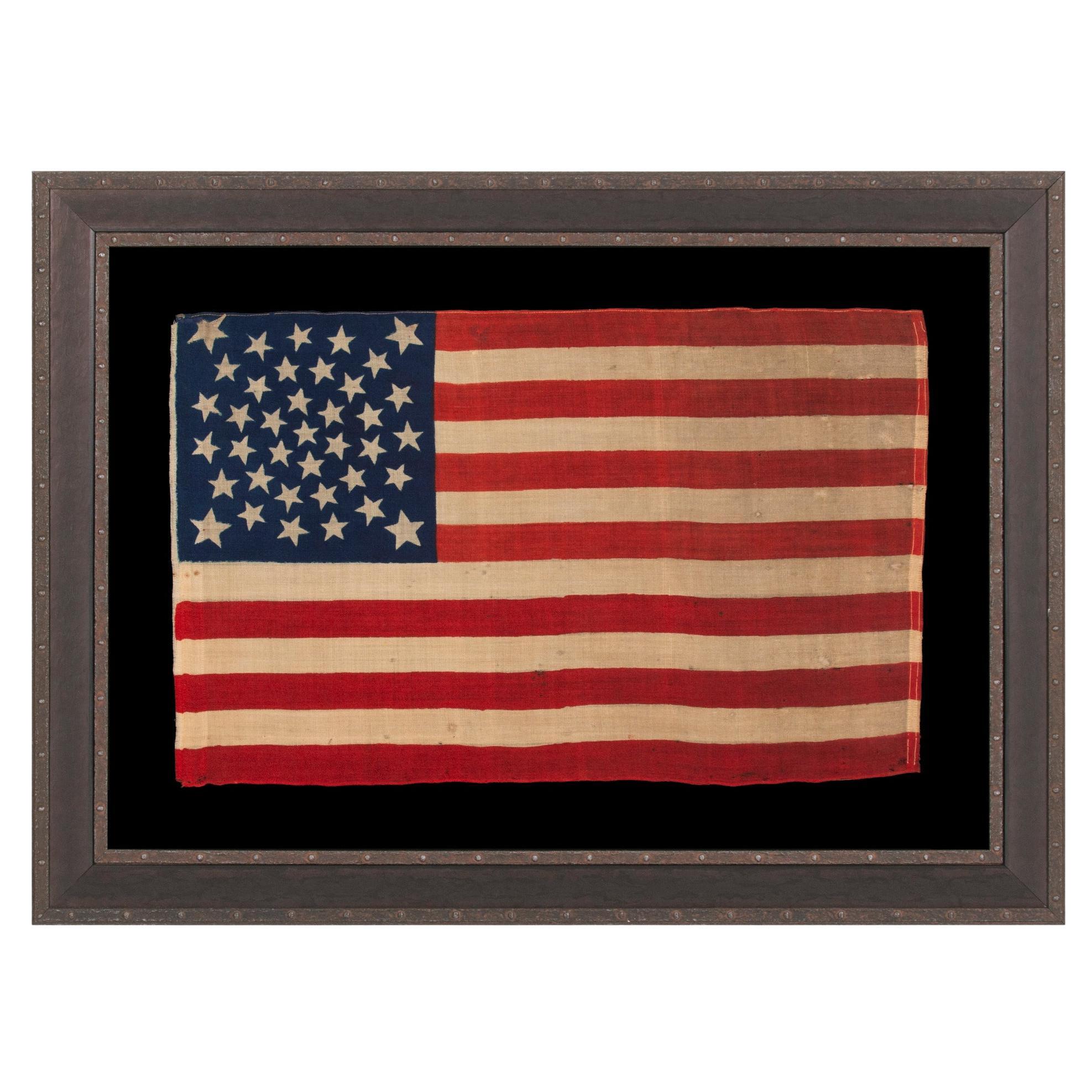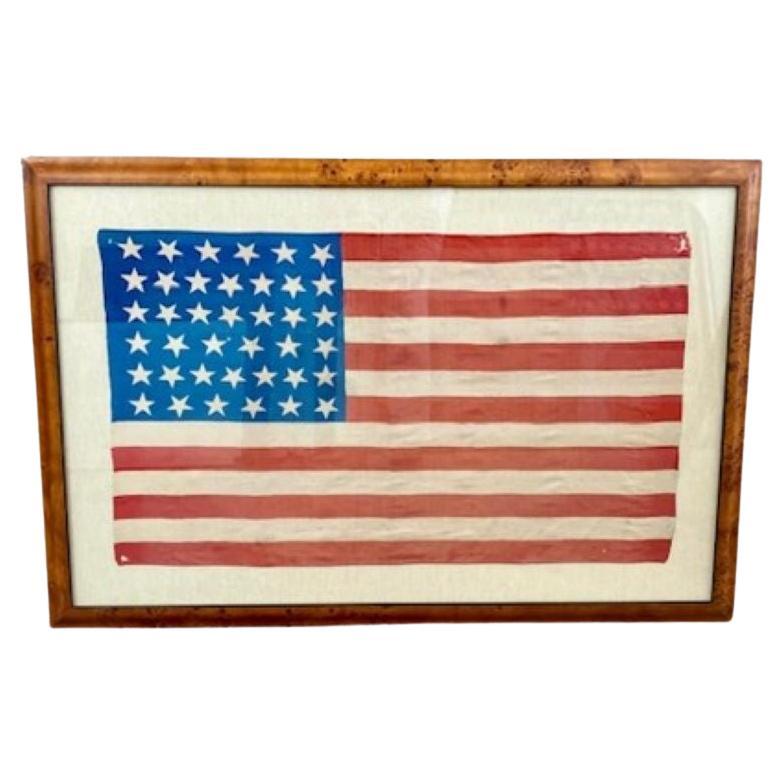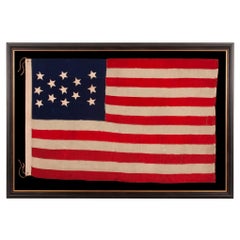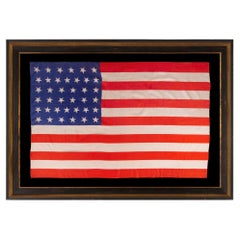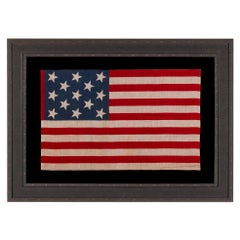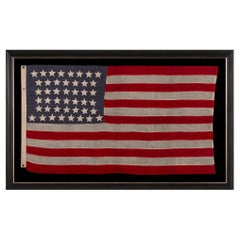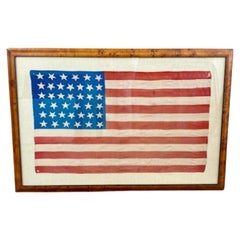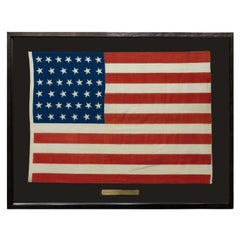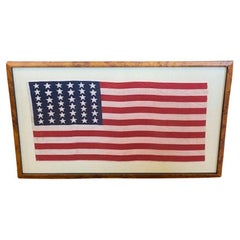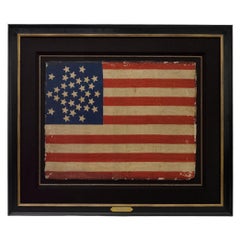Artículos similares a Bandera americana antigua de 13 estrellas, marcada "R.H Macy & Co", circa 1895-1926
¿Quieres más imágenes o vídeos?
Solicita imágenes o vídeos adicionales al vendedor
1 de 7
Bandera americana antigua de 13 estrellas, marcada "R.H Macy & Co", circa 1895-1926
Precio a petición
Acerca del artículo
13 STAR ANTIQUE AMERICAN FLAG WITH A 3-2-3-2-3 CONFIGURATION OF STARS; A SMALL-SCALE EXAMPLE, MADE IN THE 1895-1926 ERA, MARKED “R.H. MACY & CO.”
13 star antique American flag of the small-scale type made during the last decade of the 19th century through the beginning of the 20th. The canton and stripes are made of wool bunting that has been pieced with lineal, machine stitching. The stars are made of cotton and are double-appliquéd (applied to both sides) with a zigzag machine stitch. These are arranged in staggered rows of 3-2-3-2-3. There is a narrow, twill cotton binding along the hoist, folded over at the top and bottom for added strength, prior to installation, with two white metal grommets.
Because there was no official star design for the American flag until 1912, the star pattern was left to the whims of the maker. The 3-2-3-2-3 design became the most often seen 13 star configuration during the latter 19th century and remained so throughout the first quarter of the 20th. In most cases this can also be viewed as a diamond of stars, with a star in each corner and a star in the very center. It is likewise of interest to note that it can also be interpreted as a combination of the crosses of St. Andrew and St. George, which may reflect a link between this arrangement and the British Union Jack.
The 3-2-3-2-3 pattern is often attributed--erroneously in my opinion--to New Jersey Senator Francis Hopkinson, a member of the Second Continental Congress and of the Marine Committee, and signer of the Declaration of Independence, who is generally credited with having played the most significant role in the design of the American national flag prior to its June 14th, 1777 adoption. As an amateur artist and an enthusiast in heraldry, Hopkinson designed various official colonial American devices, including the Great Seal of the Treasury and various pieces of colonial currency. He also submitted designs for the Great Seal of the United States. Although Hopkinson’s original sketches for the American flag do not survive, his depictions of 13 star arrangements on other devices do not reflect the 3-2-3-2-3 configuration falsely attributed to him. This seems to have developed from someone’s unsuccessful attempt to make sense of the designs he presented on both drafts submitted to Congress for the Great Seal, which were decidedly random and most certainly intentional in this regard.
The canton and stripes of the flag are made of wool bunting that has been pieced with machine stitching. The stars are made of cotton and double-appliquéd (applied to both sides of the flag) with a zigzag machine stitch. There is a twill cotton binding along the hoist, with two brass grommets, along which “2X3” appears in a faded, red-inked stencil, and the same is hand-inscribed in pencil, to indicate size in feet.
The name “R.H. MACY & CO.” is boldly stenciled in black, near the top of the hoist, likely to indicate ownership. This flag would likely have been displayed by Macy’s department store as decoration, possibly for the opening of its Herald Square location in 1902, or in the patriotism of WWI (U.S. involvement 1917-18), or perhaps to celebrate the 150th anniversary of American independence in 1926. Although Macy’s is likely to have also sold flags, the fact that I have seen just two others with this mark may suggest more limited use.
Why 13 Stars? As the number of stars grew with the addition of new states, it became more and more difficult to fit their full complement on a small flag. The stars would, by necessity, have to become smaller, which made it more and more difficult to view them from a distance as individual objects. The fear was that too many stars would become one white mass and distort the ability to identify American ships on the open seas.
The U.S. Navy used 13 stars on its small-scale flags for precisely this reason. This was, of course, the original number of stars on the first American national flag, by way of the First Flag Act of 1777, and equal to the number of original colonies that became states.
For all practical purposes, commercial flag-makers simply didn't produce flags with pieced-and-sewn construction that were 3 to 4 feet in length before the 1890's. There are exceptions to this rule, but until this time, the smallest sewn flags were generally around 6 feet on the fly. Lengths of 8 feet long and larger were common. Their primary use long having been more utilitarian than decorative, to serve well as signals, flags needed to be large to be effective. Pre-1890, even those sewn flags made for general patriotic display were typically way larger than their modern counterparts. While most early use of flags with sewn construction was to mark ships and government buildings, eventually spreading to local militia and to formal U.S. & state military companies, private use grew with the passage of time, raising the need for long-term use flags of a more manageable scale.
Beginning around 1890, commercial flag-makers began to produce small flags for the first time in large quantities, namely with dimensions of 2 x 3 feet, like this example, or 2.5 x 4 feet. Applying the same logic as the U.S. Navy, they chose the 13 star count rather than the full complement of stars for sake of ease and visibility. Because any flag that has previously been official remains so according to the flag acts of Congress, all 13 star, 13 stripe flags remain official national flags of the United States of America.
The 13 star count has been used throughout our nation's history for a variety of purposes. In addition to being flown by the Navy, 13 star flags were hoisted at patriotic events, including Lafayette’s visit in 1824-25, the celebration of the nation's centennial in 1876, and the sesquicentennial in 1926, as well as for annual celebrations of Independence Day. They were displayed during the Civil War, to reference past struggles for American liberty, and were used by 19th century politicians in political campaigning. The use of yachting ensigns with a wreath of 13 stars surrounding a fouled anchor, which allowed pleasure boats to bypass customs between 1848 and 1980, persists today without an official purpose.
Brief History of R.H. Macy & Co.
“Rowland Hussey Macy opened four retail dry goods stores between 1843 and 1855. One of them was the original Macy's store in downtown Haverhill, Massachusetts; it opened in 1851 to serve the mill industry employees of the area. They all failed, but he learned from his mistakes. Macy moved to New York City in 1858, to establish a new store named "R. H. Macy & Co." on Sixth Avenue between 13th and 14th Streets. The location was far north of where other dry goods stores were at the time…
“As the business grew, Macy's expanded into neighboring buildings, opening more and more departments. The store used publicity devices such as a store Santa Claus, themed exhibits, and illuminated window displays to draw in customers…
In 1875, Macy took on two partners, Robert M. Valentine (1850–1879), a nephew; and Abiel T. La Forge (1842–1878) of Wisconsin, who was the husband of a cousin. Macy died in 1877 from inflammatory kidney disease (then known as Bright's disease).[15] La Forge died the following year, and Valentine died in 1879. Ownership of the company remained in the Macy family until 1895, when the Straus brothers acquired the company. Isidor Straus and his brother Nathan Straus had previously held a license to sell china and other goods in the Macy's store.
In 1902, the flagship store moved uptown to Herald Square at 34th Street and Broadway, so far north of the other main dry goods emporia that it had to offer a steam wagonette to transport customers from 14th Street to 34th Street. Although the Herald Square store initially consisted of just one building, it expanded through new construction, eventually occupying almost the entire block bounded by Seventh Avenue on the west, Broadway on the east, 34th Street on the south and 35th Street on the north… In 1912, Isidor Straus died in the sinking of the Titanic at the age of 67 with his wife, Ida…
The original Broadway store was designed by architects De Lemos & Cordes, was built in 1901–02 by the Fuller Company and has a Palladian facade, but has been updated in many details. There were further additions to the west in 1924 and 1928…designed by architect Robert D. Kohn.” [Source: Wikipedia]
Macy’s Herald Square location was the biggest retail store in the world. It retained this title until 2009, when it was surpassed by Shinsegae Centum City Department Store in Busan, South Korea.
Mounting: For 25 years we have maintained our own textile conservation department, led by a master’s degree level graduate from one of the nation’s top university programs. We take great care in the mounting and preservation of flags and related textiles and have preserved thousands of examples.
The flag has been hand-stitched to 100% silk organza for support throughout. It was then hand-stitched to a background of 100% cotton twill, black in color, that was washed and treated for colorfastness. The black-painted and gilded molding, with its wide, serpentine profile, is Italian. The glazing is U.V. protective acrylic (Plexiglas). Feel free to inquire for more details.
Condition: There is a small hole adjacent to the fly end of the 3rd red stripe, accompanied by tiny holes in the 4th, 5th, and 6th red stripes, and a couple along the lower edge of the last. There is extremely minor soiling along the hoist binding and in the stars. The overall condition is exceptional among wool flags of the period.
- Dimensiones:Altura: 88,9 cm (35 in)Anchura: 124,46 cm (49 in)Profundidad: 6,35 cm (2,5 in)
- Materiales y técnicas:
- Lugar de origen:
- Época:
- Fecha de fabricación:1895-1926
- Estado:See Item Description.
- Ubicación del vendedor:York County, PA
- Número de referencia:Vendedor: 13j-17171stDibs: LU849743948312
Sobre el vendedor
5,0
Vendedor reconocido
Estos prestigiosos vendedores son líderes del sector y representan el escalón más alto en cuanto a calidad y diseño de artículos.
Establecido en 1991
Vendedor de 1stDibs desde 2008
70 ventas en 1stDibs
Tiempo de respuesta usual: de 1 a 2 días
- EnvíoRecuperando presupuesto…Envío desde: York County, PA
- Política de devolución
Partes de esta página se han traducido automáticamente. 1stDibs no puede garantizar la exactitud de las traducciones. El inglés es el idioma predeterminado de este sitio web.
Garantía de autenticidad
En el improbable caso de que haya algún problema con la autenticidad de un artículo, ponte en contacto con nosotros en un plazo de 1 año para recibir un reembolso total. DetallesGarantía de devolución de dinero
Si tu artículo no es como se describe, sufre daños durante el transporte o no llega, ponte en contacto con nosotros en un plazo de 7 días para recibir un reembolso total. DetallesCancelación dentro de las 24 horas
Tienes un período de gracia de 24 horas para reconsiderar tu compra, sin preguntas.Vendedores profesionales aprobados
Nuestros vendedores de primera clase deben cumplir estrictos estándares de servicio para mantener la integridad de nuestros anuncios.Garantía de igualación de precios
Si encuentras que un vendedor publicó el mismo artículo por un precio menor en otro lado, igualaremos ese precio.Entrega global de confianza
Nuestra red de transporte de primera ofrece opciones de envío especializado en todo el mundo, que incluye envío personalizado.Más de este vendedor
Ver todoBandera Americana Antigua de 13 Estrellas con Presentación de Estrella Estrecha, ca 1876
BANDERA AMERICANA ANTIGUA DE 13 ESTRELLAS CON ESTRELLAS COSIDAS A MANO EN UNA PRESENTACIÓN EXTREMADAMENTE ESTRECHA DE UNA DISPOSICIÓN 3-2-3-2-3 SOBRE UN CANTÓN QUE NO SIGUE EL EJEMPL...
Categoría
Antiguo, Década de 1870, Estadounidense, Recuerdos políticos y patrióticos
Materiales
Lana
Bandera Americana Antigua de 38 Estrellas, Estado de Colorado, circa 1876-1889
Bandera de desfile americana antigua de 38 estrellas con orientación de estrellas dispersas, hecha de seda, con escala generosa y colores vivos, estadidad de Colorado, 1876-1889
B...
Categoría
Antiguo, Fines del siglo XIX, Estadounidense, Recuerdos políticos y patr...
Materiales
Seda
13 Star Antique American Parade Flag, ca 1876-1899
13 STAR ANTIQUE AMERICAN PARADE FLAG, WITH A 3-2-3-2-3 CONFIGURATION OF STARS, AN EXTREMELY SCARCE AND UNUSUALLY LARGE VARIETY, MADE circa 1876-1899
13 star American national parade...
Categoría
Antiguo, Fines del siglo XIX, Canadiense, Recuerdos políticos y patrióticos
Materiales
Algodón
Precio a petición
44 Estrellas Bandera Americana Antigua, Estado de Wyoming, ca 1890-1896
BANDERA AMERICANA ANTIGUA DE 44 ESTRELLAS CON UNA DISPOSICIÓN DE RELOJ DE ARENA SOBRE UN CANTÓN AZUL POLVORIENTO; REFLEJA LA ÉPOCA EN QUE WYOMING ERA EL ESTADO MÁS RECIENTE EN UNIRSE...
Categoría
Antiguo, Década de 1890, Estadounidense, Recuerdos políticos y patrióticos
Materiales
Lana
Bandera Americana de 38 Estrellas, Estado de Colorado, Fabricada por Horstmann Brothers ca 1876
38 ESTRELLAS, ESTADIDAD DE COLORADO, UNA ESCASA Y HERMOSA BANDERA AMERICANA ANTIGUA CON UN DISEÑO DE MEDALLÓN Y 4 GRANDES ESTRELLAS EN LAS ESQUINAS, TEÑIDA A PRESIÓN SOBRE BANDERÍN D...
Categoría
Antiguo, Fines del siglo XIX, Estadounidense, Recuerdos políticos y patr...
Materiales
Lana
Bandera Americana Antigua, 32 Estrellas, Estado de Minnesota, circa 1858-59
32 ESTRELLAS EN UNA VERSIÓN DENTADA MUY INUSUAL DEL PATRÓN DE LA "GRAN ESTRELLA", CON DOS ESTRELLAS AUSENTES EN LOS PUNTOS EXTREMOS DE CADA BRAZO, HECHA EN EL PERIODO EN QUE MINNESOT...
Categoría
Antiguo, Década de 1850, Estadounidense, Recuerdos políticos y patrióticos
Materiales
Algodón
Precio a petición
Envío gratuito
También te puede gustar
Bandera estadounidense de 39 estrellas del siglo XIX, hacia 1889
Bandera estadounidense de 39 estrellas del siglo XIX, circa 1889, bandera de desfile de seda estampada de época con un motivo ondulado de estrellas danzantes. Nunca fue una bandera o...
Categoría
Antiguo, Década de 1880, Estadounidense, Federal, Recuerdos políticos y ...
Materiales
Seda
Bandera Americana Antigua de 39 Estrellas con Estampado de Estrellas "Caprichoso", 1889
Ésta es una bandera estadounidense no oficial de 39 estrellas, hecha a mano e impresa en algodón. La bandera data de 1889 y tiene una historia única, gracias a su raro recuento de es...
Categoría
Antiguo, Década de 1880, Estadounidense, Recuerdos políticos y patrióticos
Materiales
Algodón
Bandera estadounidense de 39 estrellas del siglo XIX, hacia 1889
Bandera estadounidense de 39 estrellas del siglo XIX, hacia 1889, una enseña de lino impresa con 39 estrellas dispuestas en forma de estrella ondulada, con franjas de una forma alarg...
Categoría
Antiguo, Década de 1880, Estadounidense, Federal, Recuerdos políticos y ...
Materiales
Lino
Bandera Americana Impresa de 31 Estrellas, Celebrando la Independencia del Estado de California, Circa 1850
Ésta es una rara bandera estadounidense impresa en medallón de 31 estrellas, que celebra la incorporación de California a la Unión. La bandera está impresa en seda y tiene un especta...
Categoría
Antiguo, Década de 1850, Estadounidense, Recuerdos políticos y patrióticos
Materiales
Seda
Bandera Americana Impresa de 48 Estrellas, Conmemorativa del Estado de Arizona, 1912-1958
Se trata de una bandera de desfile original estadounidense de 48 estrellas, que celebra la condición de estado de Arizona. Maravilloso producto de la historia temprana de nuestra nac...
Categoría
mediados del siglo XX, Estadounidense, Recuerdos políticos y patrióticos
Materiales
Tela
Bandera de 38 estrellas del desfile americano, izada en una recepción al presidente Grant, 1880
Se trata de una bandera de desfile estadounidense de 38 estrellas, bellamente coloreada, que ondeó en una recepción pública para Ulysses S. Grant en octubre de 1880. Esta bandera imp...
Categoría
Antiguo, Década de 1880, Estadounidense, Recuerdos políticos y patrióticos
Materiales
Algodón
